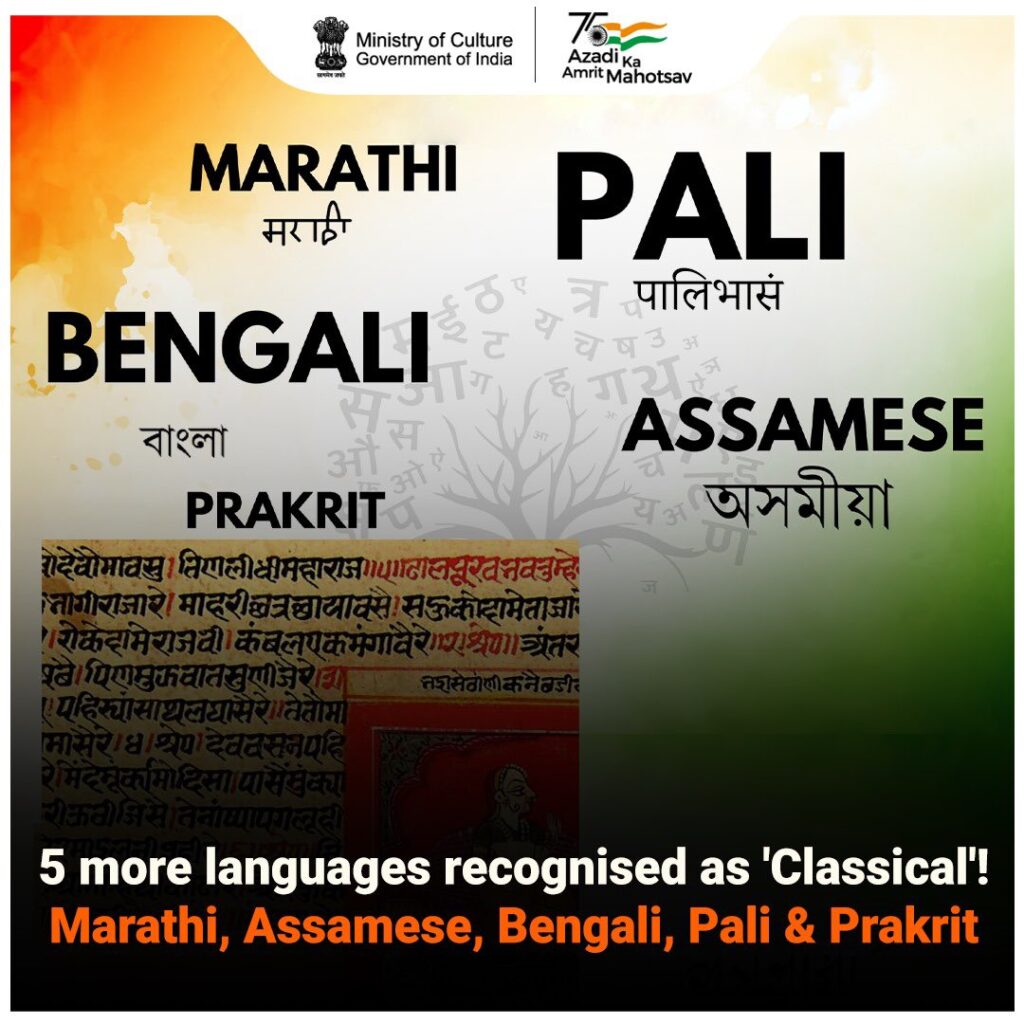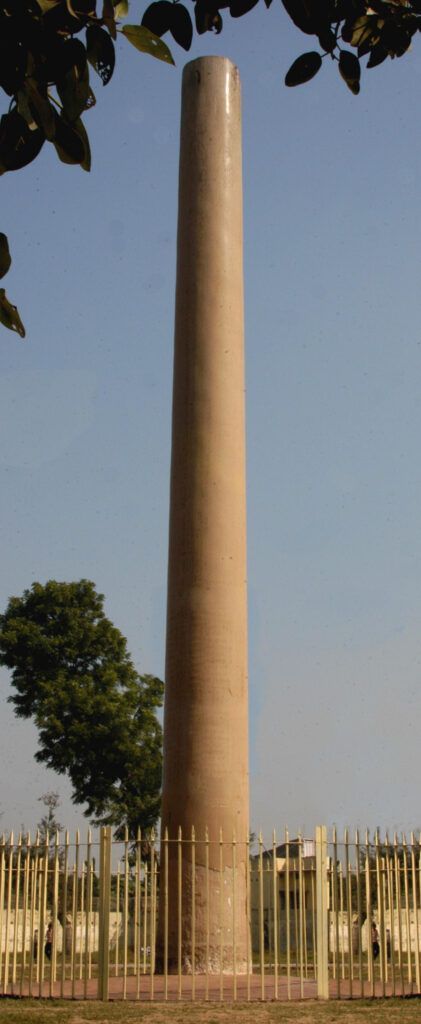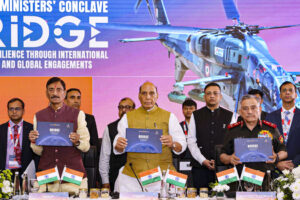A long-standing demand of linguistic experts was fulfilled on October 4 when the Union Cabinet, chaired by Prime Minister Narendra Modi, granted ‘classical language’ status to Assamese, Bengali, Marathi, Pali, and Prakrit.
With the inclusion of these five languages, the list of classical languages has now expanded to 11, including Tamil (2004), Sanskrit (2005), Telugu (2008), Kannada (2008), Malayalam (2013) and Odia (2014). Classical languages are considered the largest repositories of literature in the indigenous text of India.
On October 12, 2004, the Government of India decided to create a separate category of languages called classical languages called classical languages

for which a Linguistic Experts Committee (LEC) under the Ministry of Culture was set up to recommend various Indian languages that could be granted a separate and protected status. For this the LEC set three criteria: i) high antiquity of early texts and recorded history over 1,000 years; ii) a body of ancient literature and texts, which is considered a valuable heritage by generations of speakers; iii) the literary tradition must be original and not borrowed from another ‘speech’ community. These criteria were used to grant Tamil classical language status in 2004.
In 2005, the LEC expanded the criteria to include a fourth point that said “the classical language and literature being distinct modern languages, there may also be discontinuity between the classical language and its later form”. The LEC also extended the period of antiquity from 1,000 years to 1,500-2,000 years. The modified criteria were then used to elevate Sanskrit to a classical language in 2005, despite being discontinued in everyday use.
In 2013, the Ministry of Culture received a proposal from the Government of Maharashtra for granting Marathi classical language status, which was forwarded to the LEC. But in 2017, when the draft note recommending Marathi be granted classical language status was circulated at an
With the inclusion of these five languages, the list of classical languages has now expanded to 11, including Tamil (2004), Sanskrit (2005), Telugu (2008), Kannada (2008), Malayalam (2013) and Odia (2014). Classical languages are considered the largest repositories of literature in the indigenous text
inter-ministerial cabinet meeting, the Ministry of Home Affairs (MHA) advised that the criteria for evaluation be made stricter. The PMO also weighed in by directing the Ministry of Culture to examine how many Indian languages could likely be eligible for the classical language tag. Meanwhile, Assam, Bihar and West Bengal too submitted applications to the Ministry of Culture for granting Assamese, Pali, Prakrit and Bengali the special status.
On July 25, 2024, the LEC in a meeting held under the aegis of the Sahitya Akademi,

Inscriptions on Ashoka’s pillars are in Prakrit language in Brahmi script

after considering the guidelines issued by the PMO and the MHA, revised the third criterion to include “knowledge texts, es-pecially prose texts in addition to poetry, epigraphical, and inscriptional evidence” for evaluating any language for granting classical status. The LEC then said that As-samese, Bengali, Marathi, Pali, and Prakrit fulfilled the revised criteria, and bestowed upon these languages the special status.
According to the Ministry of Culture, the designation of a language as ‘classical’ is intended to recognise its historical significance and its role as a guardian of India’s rich cultural and intellectual heritage. These languages have been essential in preserving and transmitting ancient knowledge systems, philosophies, and values across generations for thousands of years. By recognising these languages as classical, the government acknowledges their deep-rooted antiquity, vast literary traditions, and their invaluable contribution to the cultural fabric of the nation. This recognition highlights the significant cultural and linguistic contributions these languages have made to India’s heritage.
Pali and Prakrit, unlike the other three languages that have been granted the special status, are no longer in everyday usage, but their antiquity dates back several millennia and many notable inscriptions and texts of historical significance can be found across the Indian subcontinent. The term “Pali Bhasha”, or Pali lan
Number of Manuscripts
Preserved by National
Mission of Manuscripts
Prakrit 80,278
Marathi 44,712 Bengali 39,927
Assamese 38,295
Pali 496
guage, is a modern coinage, and its exact origin remains a topic of debate among scholars. Up until the sixth or seventh century, there was no specific language known as Pali. The earliest references to Pali are found in the commentaries of the Buddhist scholar, Buddhaghosa. Several theories have emerged regarding the origins of Pali.
Max Walleser (German Indologist) suggested that Pali is derived from “Patal” or “Padali”, potentially indicating a connection to the language of Pataliputra. R.C. Childers (British Orientalist and the compiler of the first Pali-English dictionary) believed that Pali was a vernacular spoken by the common people. At the same time, James de Alwis (a colonial era legislator from Ceylon, now called Sri Lanka) identified it as the language of Magadha, prevalent during the time of Buddha. De Alwis argued that Magadhi was the original name for Pali, and it was used extensively until the time of Emperor Ashoka.
The antiquity of the Prakrit language is widely acknowledged among linguists and scholars. Renowned exponents of the language included Panini, Chand, Vararuchi, and Samantbhadra, who shaped its grammatical structure. Prakrit inscriptions serve as vital historical records, providing insights into India’s past. The inscriptions from the pre-Mauryan period, as well as those from Emperor Ashoka and Kharvel, are written in Prakrit.
The Ministry of Education has taken various steps to promote classical languages. Three Central universities were established in 2020 through an Act of Parliament for the promotion of Sanskrit. The Central Institute of Classical Tamil was set up to facilitate the translation of ancient Tamil texts, promote research and offer courses for university students and language scholars of Tamil. To further enhance the study and preservation of classical languages, Centres of Excellence for studies in classical Kannada, Telugu, Malayalam and Odia were established under the Central Institute of Indian Languages in Mysuru.
In addition to these initiatives, several national and international awards have been instituted to recognise and encourage achievements in the field of classical languages. Benefits extended to classical languages by the Ministry of Education include national awards for classical languages, chairs in universities and centres for promotion of classical languages.





Add Comment